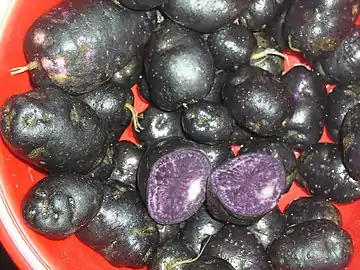Vitelotte
'Vitelotte', also called Vitelotte noire, Négresse[1]:150 or Truffe de Chine,[2] is a gourmet French variety of blue-violet potato.[3] It has been cultivated in France at least since the early nineteenth century.
| Potato 'Vitelotte' | |
|---|---|
 'Vitelotte' potatoes | |
| Genus | Solanum |
| Species | Solanum tuberosum |
| Cultivar | 'Vitelotte' |
| Origin | France |

Description
'Vitelotte' potatoes have a dark blue, almost black, skin and dark violet-blue flesh; they have a characteristic nutty flavour and smell of chestnuts. The colour is retained in cooking, and is due to natural pigments in the anthocyanin group of flavonoids.[4] The plants mature late and, compared to modern varieties, are relatively low-yielding. The tubers are elongated with sunken eyes;[2] they are thick-skinned, and thus keep well.
Etymology
The French word vitelotte derives from the archaic French: vit, meaning "penis" (modern French bite), by analogy with the shape of the tuber. The first occurrence of the word is from 1812.[5]
History
In early descriptions, vitelotte were not necessarily violet-coloured. In a source from 1817, six varieties of potato are listed as available at the market of Les Halles; among them are both vitelotte and violette ("violet").[6]:508 A treatise on agriculture published in 1863 lists five possible colours for the vitelotte: white, yellow, pink, red and violet.[7] In 1873 Alexandre Dumas wrote in his Grand dictionnaire de cuisine:[8]:847
"... the best of all are unquestionably the violet [ones], preferable even to the red [ones], [and] known in Paris by the name of Vitelottes'".
Gallery
 Vitelotte potatoes
Vitelotte potatoes Vitelotte potatoes, whole and halved
Vitelotte potatoes, whole and halved Crisps made with Vitelotte potatoes
Crisps made with Vitelotte potatoes The leaves and stalks may also show violet colouring
The leaves and stalks may also show violet colouring
References
- Robert Diehl (1938). La pomme de terre: caractères et description des variétés (in French). Paris: Imprimerie nationale.
- Vitelotte Noire, Négresse (in French). Le Plant Français de Pomme de Terre. Accessed May 2013
- [s.n.] (2008) International Year of the Potato 2008: New light on a hidden treasure: an end-of-year report. Food and Agriculture Organization of the United Nations. Archived 11 May 2020.
- Silke Hillebrand, Heike Naumann, Nina Kitzinski, Nils Köhler, Peter Winterhalter (2009) Isolation and Characterization of Anthocyanins from Blue-fleshed Potatoes (Solanum tuberosum L.). Institute of Food Chemistry, Technische Universität Braunschweig, Braunschweig, Germany. Archived 22 October 2015.
- Vitelotte (in French). Centre National de Ressources Textuelles et Lexicales. Accessed May 2013.
- [s.n.] (1817) Mémoires d'agriculture, d'économie rurale et domestique; publiés par la Société royale et centrale d'agriculture (in French). Paris: Librairie de Madame Huzard.
- Jean Pierre Louis Girardin, Alphonse Du Breuil (1863) Traité élémentaire d'agriculture, Volume 2 (in French). Bibliothèque de la ferme et des maisons de campagne. Paris: Garnier frères. p. 7–11.
- Alexandre Dumas (1873) Grand dictionnaire de cuisine (in French). Paris: Alphonse Lemerre.
"… les meilleures de toutes sont sans contredit, les violettes, préférables mêmes aux rouges, connues à Paris sous le nom de Vitelottes"
| Wikimedia Commons has media related to Solanum tuberosum 'Vitelotte'. |